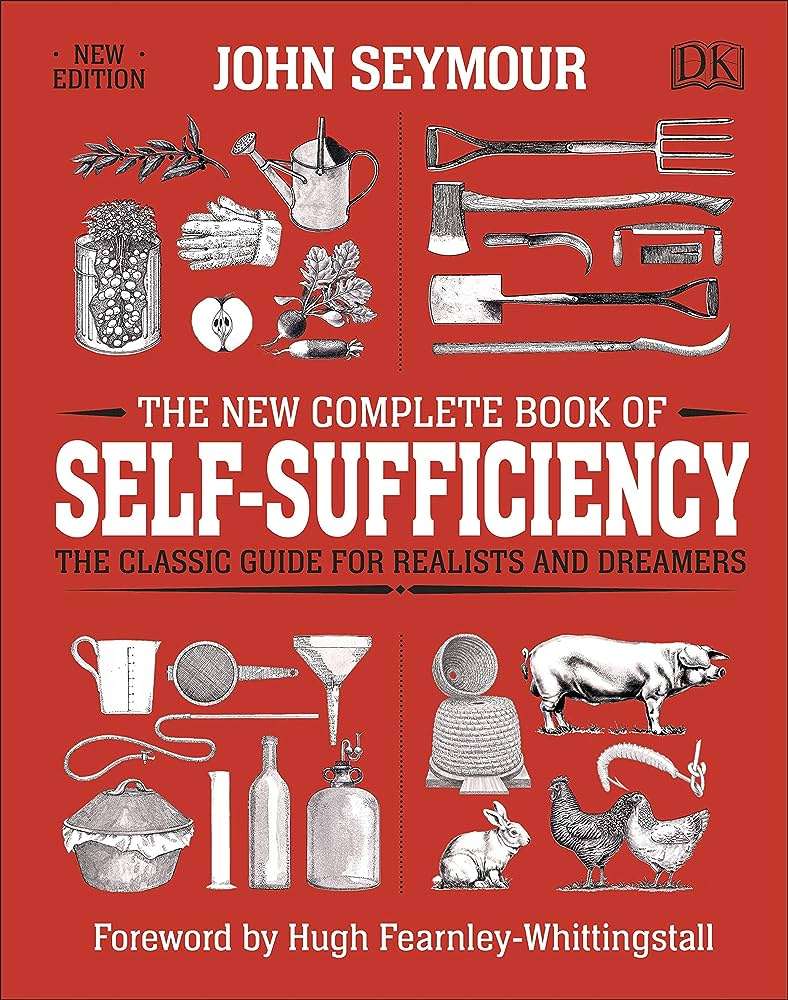In this article, we’ll explore the journey towards complete self-sufficiency and uncover the path that leads to it. We’ll delve into the realm of off-grid living and discover how it can pave the way for a more independent and sustainable lifestyle. Additionally, we’ll learn practical tips on how to achieve 100 percent self-sufficiency, enabling you to rely solely on your own resources. So, let’s embark on this exciting journey together and uncover the secrets to becoming completely self-sufficient.
Discovering the Path to Complete Self-Sufficiency
Introduction
Have you ever dreamed of living a life free from the constraints of modern society, where you rely solely on your own resources to meet your needs? The journey towards complete self-sufficiency is a path less traveled, but one that offers great rewards. In this article, we will explore the concept of self-sufficiency, delve into the world of off-grid living, discuss sustainable food production and renewable energy options, explore water management strategies and alternative building materials, and touch upon essential skills and financial practices that are crucial for achieving self-sufficiency. So, buckle up and get ready to embark on a journey towards discovering the path to complete self-sufficiency.
Understanding Self-Sufficiency
Defining self-sufficiency
Self-sufficiency refers to the ability to fulfill all your basic needs without relying on external resources or assistance. It encompasses various aspects of life, including food production, energy generation, water management, and building infrastructure. By adopting a self-sufficient lifestyle, you become more resilient, independent, and environmentally conscious.
Benefits of self-sufficiency
Embracing self-sufficiency offers numerous benefits for individuals and communities alike. Firstly, it provides a sense of security and peace of mind, as you are not dependent on external systems that may be vulnerable to disruption or failure. Additionally, self-sufficiency promotes sustainability by reducing your carbon footprint and minimizing waste. It also fosters a deeper connection with nature and encourages a simpler, more intentional way of living. Furthermore, by becoming self-sufficient, you can inspire and empower others to follow suit, thus creating a positive ripple effect within your community.
Factors influencing self-sufficiency
While self-sufficiency is an admirable goal, it is essential to acknowledge the factors that can influence its achievement. Geographic location, available resources, climate conditions, and personal skills and knowledge all play a significant role in determining the level of self-sufficiency one can attain. It is important to set realistic goals and adapt your strategies to your specific circumstances in order to navigate the journey successfully.

Embracing Off Grid Living
What is off-grid living?
Off-grid living involves disconnecting from public utilities such as electricity, water, and sewage systems, and relying instead on self-generated resources. It allows individuals to break free from the constraints of urban living and embrace a simpler, more sustainable lifestyle. Off-grid living can take many forms, from living in remote areas with no access to public infrastructure to adopting energy-efficient and self-sufficient practices in urban environments.
Advantages of off-grid living
Living off-grid offers numerous advantages and opportunities for personal growth. Firstly, it allows you to become more self-reliant, as you learn to generate your own energy, manage your water supply, and grow your own food. This level of independence fosters a deeper connection with nature and stimulates a sense of resourcefulness and creativity. Furthermore, off-grid living promotes a reduced ecological footprint, as you are not reliant on energy derived from fossil fuels or contributing to the overconsumption of resources.
Challenges of off-grid living
While off-grid living has its advantages, it also poses unique challenges. One of the primary challenges is the initial investment required to set up the necessary infrastructure, such as installing solar panels, rainwater harvesting systems, and waste management solutions. Additionally, off-grid living requires a certain level of technical knowledge and practical skills. It may also involve adapting to a different lifestyle, with limited access to certain conveniences. However, with careful planning, perseverance, and a willingness to learn, these challenges can be overcome, leading to a fulfilling and sustainable off-grid lifestyle.
Sustainable Food Production
Organic gardening techniques
One of the pillars of self-sufficiency is the ability to grow your own food. Organic gardening techniques promote sustainable and environmentally friendly practices, ensuring a healthy and abundant harvest. Among these techniques are natural pest and weed control methods, composting, crop rotation, and companion planting. By implementing these practices, you not only produce nutritious food but also contribute to the preservation of the ecosystem.
Permaculture principles
Permaculture is a holistic approach to sustainable living that focuses on designing systems that are harmonious with nature and self-sustaining. By embracing permaculture principles, you can create a productive and resilient food system that mimics natural ecosystems. Some of the key principles include observing and interacting with your surroundings, capturing and storing energy, integrating diverse elements, and valuing renewable resources. Permaculture is a powerful tool that empowers individuals to create sustainable food production systems tailored to their specific needs and circumstances.
Animal husbandry practices
In addition to growing fruits and vegetables, self-sufficiency can also involve raising animals for food, fibers, or companionship. Animal husbandry practices can range from backyard chicken keeping to larger-scale livestock production. By keeping animals ethically and responsibly, you can enhance your self-sufficiency efforts by incorporating animal products into your diet, utilizing manure for fertilization, or even generating income through the sale of animal products. However, it is crucial to ensure the welfare of the animals and manage their impact on the environment in a sustainable manner.

Harnessing Renewable Energy
Solar power systems
One of the most popular and accessible forms of renewable energy is solar power. Solar panels convert sunlight into electricity, providing a clean and sustainable source of energy. By installing a solar power system, you can generate electricity for your household needs, such as lighting and appliance use. This not only reduces your reliance on the grid but also helps combat climate change by reducing greenhouse gas emissions. Furthermore, advancements in solar technology have made it more affordable and efficient, making it a viable option for those seeking self-sufficiency.
Wind turbines
Wind turbines harness the power of the wind to generate electricity. They are particularly suitable for individuals living in areas with consistent and adequate wind resources. Installing a wind turbine can provide a stable source of renewable energy, complementing other sustainable practices such as solar power. While wind turbines require more maintenance and space compared to solar panels, they offer the advantage of producing energy even during cloudy or low-sunlight conditions.
Hydroelectricity generation
If you have access to a running water source such as a river or stream, harnessing hydroelectricity can be a viable option for generating clean energy. By employing turbines, the mechanical energy of the flowing water is converted into electricity. Hydroelectric power systems can be small-scale, suitable for individual households or larger-scale installations that supply power to communities. However, it is important to consider the environmental impact and regulations associated with such systems before embarking on hydroelectricity generation.
Water Management Strategies
Rainwater harvesting
Water is a precious resource, and self-sufficiency entails responsibly managing and conserving it. Rainwater harvesting involves collecting and storing rainwater for various uses, such as watering plants, cleaning, or even drinking. This practice reduces the demand for groundwater or public water supplies, especially in areas facing water scarcity. Rain barrels, tanks, or cisterns can be used to capture rainwater, and filtration systems can ensure its suitability for different purposes.
Water filtration systems
Ensuring the quality of your water supply is crucial for maintaining good health and hygiene. Implementing water filtration systems allows you to purify rainwater, well water, or even tap water, if necessary. There are various filtration methods available, ranging from simple filters to more advanced systems capable of removing contaminants such as bacteria, viruses, and chemicals. By investing in water filtration, you can have peace of mind knowing that your water is safe for consumption and other household uses.
Greywater recycling
To further maximize your water resources, greywater recycling can be employed. Greywater refers to the wastewater generated from sources such as sinks, showers, and washing machines. Instead of allowing this water to be wasted, it can be treated and reused for purposes like irrigation or flushing toilets. Greywater recycling systems range from simple setups involving gravity-fed filtration to more complex systems that utilize pumps, filters, and storage tanks. Reusing greywater not only reduces the strain on freshwater supplies but also minimizes the pollution of natural water bodies.

Building and Infrastructure
Alternative construction materials
Traditional construction materials such as concrete and bricks often have a significant environmental impact. However, there is a wide array of alternative materials available that are more sustainable and resource-efficient. Examples include bamboo, straw bales, recycled materials, and earth-based materials like adobe or rammed earth. These materials not only have lower carbon footprints but also offer excellent insulation properties and can contribute to healthier indoor environments.
Building design for energy efficiency
Building design plays a crucial role in minimizing energy consumption and optimizing self-sufficiency efforts. By implementing passive design strategies, such as orienting your building to maximize natural light and ventilation, utilizing thermal mass, and insulating effectively, you can reduce the need for mechanical heating, cooling, and lighting. Additionally, incorporating energy-efficient appliances and systems, such as LED lighting and energy-efficient HVAC systems, further reduces your energy demands.
Waste management solutions
Proper waste management is an integral part of self-sufficiency and sustainable living. Implementing recycling, composting, and waste reduction strategies can significantly reduce the amount of waste sent to landfills. Composting organic waste not only diverts it from landfills but also yields nutrient-rich compost that can be used to enhance soil fertility in your garden. Recycling materials such as paper, plastic, glass, and metal reduces the need for virgin resources and minimizes environmental degradation.
Developing Essential Skills
Basic survival skills
Complete self-sufficiency requires a range of essential skills that enable you to thrive in various situations. Basic survival skills, such as fire-making, shelter-building, foraging, and navigation, equip you with the ability to survive and adapt to unforeseen circumstances. Acquiring these skills not only enhances your self-sufficiency but also instills confidence and resilience in the face of challenges.
First aid and medical knowledge
Having a basic understanding of first aid and medical knowledge is imperative for maintaining your well-being in self-sufficient living. Knowing how to respond to minor injuries, perform CPR, and recognize the signs of serious medical conditions can be lifesaving in remote or emergency situations. Additionally, familiarizing yourself with natural remedies, herbal medicine, and basic healthcare practices enables you to address common ailments and promote good health within your self-sufficient lifestyle.
Handyman and repair skills
Self-sufficiency often requires hands-on problem-solving and practical skills. Developing handyman and repair skills, such as carpentry, plumbing, electrical work, and mechanical know-how, allows you to maintain and fix your infrastructure and equipment. Not only does this save resources and money, but it also gives you a sense of empowerment and self-reliance.

Self-Sufficient Financial Practices
Reducing dependency on external income
A crucial aspect of self-sufficiency is financial independence and reducing dependency on external income sources. By minimizing expenses and living within your means, you can allocate more resources towards self-sufficiency efforts. This may involve downsizing, simplifying your lifestyle, and carefully managing your finances to prioritize self-sustainability.
Barter and trade networks
Creating and participating in local barter and trade networks can enhance your self-sufficiency journey. By exchanging goods and services with others in your community, you can acquire necessary resources, diversify your skill set, and establish valuable connections. Bartering promotes a sense of interdependence and community support, fostering resilience and self-sufficiency within your local ecosystem.
Creating multiple income streams
While reducing external income is desirable, it is still important to have some sources of revenue to support your self-sufficient lifestyle. Creating multiple income streams can provide financial stability and flexibility. This can involve monetizing your self-sufficiency efforts, such as selling surplus produce, handmade crafts, or offering workshops and consultations based on your expertise. Diversifying your income sources mitigates risks and allows you to invest in further self-sufficiency endeavors.
Health and Well-being in Self-Sufficiency
Maintaining physical fitness
Self-sufficiency often involves physical labor and active living. Maintaining physical fitness is essential for coping with the demands of a self-sufficient lifestyle. Regular exercise, whether through gardening, animal care, or engaging in physical activities, strengthens your body and improves overall well-being. It is important to listen to your body’s needs and ensure you have a balanced approach to physical fitness, incorporating rest and recovery.
Mental and emotional resilience
The journey towards complete self-sufficiency can be challenging, requiring determination, patience, and adaptability. Developing mental and emotional resilience is instrumental in navigating the ups and downs of this path. Prioritize self-care, emphasize stress management techniques such as meditation, mindfulness, and engage in activities that bring you joy and fulfillment. Cultivating a positive mindset and developing emotional intelligence will help you overcome obstacles and maintain a sustainable self-sufficient lifestyle.
Community support and networking
Self-sufficiency does not mean isolating yourself from society. Building a supportive community of like-minded individuals adds value to your self-sufficiency journey. Sharing knowledge, resources, and experiences with others fosters collaboration, strengthens resilience, and provides a safety net during challenging times. Engage in local community initiatives, participate in workshops, and connect with individuals who share your vision for self-sufficiency. Together, you can create a strong support network that enhances everyone’s self-sufficiency efforts.

Overcoming Challenges and Limitations
Dealing with unpredictable circumstances
As with any journey, the path to complete self-sufficiency is not without its challenges. Unpredictable circumstances, such as extreme weather events, natural disasters, or unexpected changes in personal circumstances, can disrupt self-sufficiency efforts. Creating contingency plans and remaining adaptable are crucial in overcoming such challenges. Having backup resources, alternative strategies, and a resilient mindset will help you bounce back from setbacks and continue progressing towards your self-sufficiency goals.
Managing limited resources
Self-sufficiency often involves managing limited resources, such as land, water, and energy. Learning to optimize and stretch these resources is key to long-term sustainability. Implementing efficient water and energy practices, recycling and reusing materials, and utilizing space-saving techniques maximize the productivity of your resources. Promote circular systems where waste from one process becomes a resource for another. By continually evaluating and improving resource management, you can make the most of your self-sufficient endeavors.
Adapting to changing environments
The environment around us is constantly evolving, and adapting to these changes is fundamental in maintaining self-sufficiency. Climate change, shifts in market conditions, or regulatory requirements may necessitate adjustments to your strategies. Staying informed, regularly evaluating and updating your plans, and seeking innovative solutions enable you to adapt your self-sufficient practices to changing environments. Flexibility and resilience will be instrumental in overcoming these challenges and continuing on your path towards complete self-sufficiency.
Balancing Self-Sufficiency and Modern Life
Finding harmony between self-sufficiency and technology
Complete self-sufficiency does not necessarily mean completely disconnecting from modern technology. Rather, it involves striking a balance between sustainable practices and utilizing appropriate technology to enhance your efforts. Embrace technologies that align with your self-sufficient goals, such as energy-efficient appliances, water-saving devices, or digital tools for planning and monitoring. Leverage technology as a tool to complement and optimize your self-sufficiency endeavors without compromising your core values.
Maintaining social connections
While self-sufficiency emphasizes independence and self-reliance, it is vital to maintain social connections and foster healthy relationships. Engaging with others, whether within your self-sufficiency community or broader social circles, provides support, inspiration, and opportunities for learning. Sustaining these connections helps combat feelings of isolation and promotes a well-rounded and fulfilling self-sufficient lifestyle.
Navigating legal and regulatory requirements
As you embark on your journey towards complete self-sufficiency, it is important to be aware of and comply with legal and regulatory requirements. Land-use restrictions, zoning ordinances, health and safety regulations, and taxation laws may vary depending on your location and circumstances. Familiarize yourself with applicable regulations, seek legal advice if necessary, and ensure your self-sufficiency practices align with local laws. Navigating these requirements is essential for maintaining a harmonious relationship with your community and authorities.
Conclusion
The path to complete self-sufficiency is a transformative journey that enables individuals to lead sustainable, resilient, and fulfilling lives. By understanding the principles and benefits of self-sufficiency, embracing off-grid living, implementing sustainable food production and renewable energy practices, adopting water management strategies, utilizing alternative building materials, acquiring essential skills, practicing self-sufficient financial strategies, nurturing health and well-being, overcoming challenges, and finding balance between self-sufficiency and modern life, you can embark on this path with confidence and determination. So, start exploring, learning, and taking action towards discovering your own unique path to complete self-sufficiency and embrace a more sustainable future.




